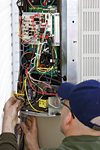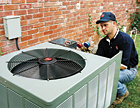
Technologies continue to evolve and as new processes become available this will lead to higher levels of efficiency in both heating and cooling equipment.
As HVAC products get more and more efficient, the logical question is what level will they top off at? The laws of physics can limit the efficiency levels of air-source heating and cooling equipment. The laws of economics also come into play, as the cost for each incremental escalation in efficiency can substantially increase the cost of the equipment.
That being said, technologies will continue to evolve, new processes will become available, and both will lead to higher levels of efficiency in heating and cooling equipment - just how much higher, though, is open to debate.
FROM HERE TO HIGHER SEER
“We are at an all-time high on efficiency levels, but there is still room for it to grow,” said Jeff Goss, product manager, residential cooling, Rheem. “Today, there are some select air-to-air systems that currently exceed 23 SEER. However, the industry is constantly evolving and adapting new technologies which mean that there are always opportunities to improve upon even the latest technological innovations.”“We’re not convinced that the energy efficiency levels of cooling units have achieved the highest possible level yet,” said Jim Fisher, product manager, Goodman Global Group, Inc. “Many opportunities are on the horizon that may be used to reduce the energy consumption of central cooling systems.”
Those opportunities include the continual creation, development, and availability of technology, components, and systems that are constantly being refined and improved. “A compressor, fan/motor, coil, and refrigerant are the major elements of a central cooling system, and as improvements are made to one specific component, the efficiency of the unit could be improved,” said Fisher.
Theoretically, noted Nathan Wright, director of process and support, Ingersoll Rand – Residential Solutions, SEER could go as high as 921 and EER 123. However, “these limits would require electrical components, such as motors and compressors, to be 100 percent efficient. It would also require infinitely large heat exchangers with infinite amounts of air moving through them infinitely slowly. These systems would be extremely limited in capacity and dehumidification, so while they would be ultra-efficient, they would not be practical.”

According to Nordyne, whose 22 SEER iQ Drive heat pump is shown here, inverter-driven variable-speed compressors and highly efficient blower motors are key to achieving high SEER ratings.
Allan Reifel, vice president of research and development, Nordyne, stated that the theoretical thermodynamic maximum for cooling equipment depends on the indoor and outdoor temperatures. “At the rating condition of 95°F outdoor and 80°F indoor temperatures, the theoretical limit is a COP of 36 (122.9 EER), which is the Carnot maximum thermodynamic efficiency at this condition.”
While the maximum COP would be about 36 at standard test conditions, said Tom Goodnight, product manager - residential outdoor products, Unitary Products, Building Efficiency, Johnson Controls, in practice, heat exchanger efficiency and the power consumption of system components result in a current practical maximum COP of around 4.4 for air-to-air systems.
“Technology breakthroughs that would increase the maximum practical COP could come in the areas of heat exchanger technology, motor and compressor efficiency, refrigerant efficiency, or variable capacity control. Because incremental increases in efficiency tend to follow a law of diminishing returns, and because production and installation costs are a significant factor affecting the marketability of air conditioning systems, super-high-efficiency systems usually do not offer the preferred cost-value combination for most consumers,” said Goodnight.
Given these considerations, Reifel believes that efficiencies of air-to-air, variable-speed systems will most likely plateau at 25 to 30 SEER in the next 10 years. “Inverter-driven variable-speed compressors and highly efficient blower motors are key to achieving high SEER ratings without increasing system size and refrigerant usage beyond that which is practical.”

Trane believes that in order to attain the next level of efficiency, there needs to be additional gains in compressor efficiency, heat transfer mediums, and indoor/outdoor air movement systems.
THE END IS NEAR
As far as gas furnaces are concerned, the theoretical limit is 100 percent AFUE, and the industry is already closing in on that maximum efficiency. According to Bryan Rocky, director of residential product management, Unitary Products, Building Efficiency, Johnson Controls, “With the current U.S. Department of Energy definition of AFUE, the practical upper limit is probably very close to what is achieved today, say 98.5 percent AFUE or so. A furnace achieving that level of efficiency starts getting out of the practical design considerations for size, cost, and providing acceptable comfort to customers.”According to Reifel, the gas furnace industry has already attained the highest practical efficiencies, and efforts to boost efficiencies still higher would be costly and result in negligible gains. Wright agreed, noting that, “As we get closer to reaching the 100 percent AFUE level, we are definitely seeing diminishing returns. In other words, the additional cost to gain another 0.1 to 0.5 increase in AFUE is fairly large.”
At some date in the future, stated Fisher, gas furnaces could provide efficiency levels beyond 100 percent, however, that would require the development of new or revised technology. And, as with all purchases, homeowners would have to balance the cost/benefit scale to determine whether an ultra-high efficiency gas furnace delivers the best value for their homes. “Given that the majority of the U.S. requires a high number of heating hours, more efficient furnaces should be a strong market; however, unless the load hours offset any increased cost, the enhanced efficiency levels may not be realized by a large number of homeowners.”
From a manufacturer’s perspective, time, human resources, and financial capital are three factors that could limit the development of super-high efficiency furnaces, said Terry Stern, product manager, residential heating, Rheem. “While today’s economic environment is certainly better than recent years, manufacturers still face time, HR, and capital constraints.”

Rheem is improving its air conditioners by enhancing comfort; ensuring increased reliability; adding user friendly controls; fostering greater Internet connectivity; and creating smaller size options.
Johnson Controls believes that total system integration is key, including new controls that offer benefits in flexibility, improved comfort settings for homeowners, and enhanced set-up and diagnostics for contractors. “Our customers are demanding much more out of their heating and air conditioning systems these days - high efficiency, easily understandable and usable thermostats and controls, improved IAQ and comfort in their homes, and reliable and long-lasting products that are affordable,” said Rocky. “Add in features like residential energy management functions, remote access and control, and home automation requirements, and the products today will have to change with customer’s expectations.”
Features that support quick and easy installation, diagnostics, and service will continue to be a priority for Goodman. “The delivery of heating comfort will also remain an area of improvement,” said Fisher. “Consider that homeowners today have options of single-stage, two-stage, and modulating gas furnaces at all efficiency levels. Just a few years ago several of these options were not available.”
To further improve its most efficient products, Rheem will focus its efforts on providing improved home comfort and diagnostics; advancing feature-rich thermostats; ensuring solid, quiet performance; and delivering a powerful product in a compact, space-saving size. “In addition, it’s important to note that the HVAC industry - like other industries that are using current energy sources such as gas and electric - is looking at alternative energy sources,” said Stern. “We feel there is opportunity to better leverage alternative energy sources like solar and fuel cell power in the future.”
While gas furnaces are approaching their maximum AFUEs, manufacturers will still work on finding innovative ways to wring more efficiency from their cooling equipment. These high efficiencies, combined with other cutting edge technology, will help the industry continue to boldly go where no one has gone before.
Publication date:06/20/2011


Report Abusive Comment